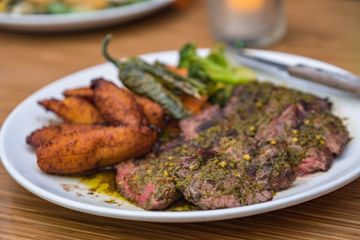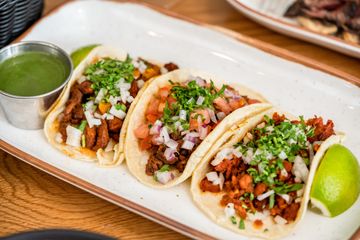Discover the Rich Flavors of Mexican Food: A Journey Via Its Popular Cuisines
Mexican cuisine supplies a tapestry of flavors and customs that show its rich cultural heritage. Each dish, from the cherished tacos to the complex mole, carries its very own story and significance. The diverse ingredients and food preparation methods highlight local variations and public dining experiences. As one discovers these prominent dishes, the deepness and range of this cooking landscape come to be significantly evident, inviting inquisitiveness regarding what exists beyond the surface area of these famous flavors.
Tacos: The Quintessential Mexican Road Food
Tacos, commonly considered the quintessential Mexican road food, embody the rich cooking traditions of Mexico. These scrumptious productions include a soft or crunchy tortilla loaded with a variety of components, showcasing a selection of textures and tastes. From savory meats like carnitas and al pastor to vegetarian choices including beans, cheese, or grilled vegetables, tacos use something for every single palate.
The simplicity of the taco permits for endless personalization, commonly covered with fresh cilantro, onions, salsas, and lime. Street vendors throughout Mexico skillfully prepare tacos, offering them warm and fresh to passionate clients. The common nature of taco intake promotes a feeling of link amongst diners, as they share diverse fillings and toppings.
This beloved recipe not just stands for the cooking creativity of Mexico but additionally works as a symbol of social identity, mirroring the dynamic spirit of the country's food scene. best mexican westchester NY.
Enchiladas: Rolled Indulge In a Flavorful Sauce
Enchiladas stand for an abundant tradition in Mexican food, showcasing a range of active ingredients and regional adjustments. The preparation of these rolled tortillas, usually filled up with vegetables, cheeses, or meats, entails certain food preparation methods that boost their flavor. Recognizing the subtleties of both standard elements and innovative variations can raise the enchilada experience.
Traditional Ingredients and Variations
Among the essential dishes of Mexican food, enchiladas are celebrated for their versatility and abundant flavors. Commonly, corn tortillas function as the base, typically filled up with a range of active ingredients such as shredded poultry, beef, cheese, or beans. The dental fillings can be complemented by a selection of sauces, ranging from red chili to environment-friendly tomatillo, each contributing its one-of-a-kind taste. Variants abound across areas, with some incorporating regional ingredients like seafood in coastal locations or mole in Oaxaca. Toppings may consist of sour cream, cheese, lettuce, or avocado, improving both taste and presentation. This versatility permits enchiladas to reflect the varied cooking heritage of Mexico, making them a beloved option for several.
Cooking Methods and Tips
Grasping the art of preparing enchiladas involves comprehending numerous cooking techniques that improve their taste and appearance. Selecting the ideal tortilla is crucial; corn tortillas are traditional and offer authentic taste. When rolled, they must be gently warmed up to protect against cracking. The dental filling, typically a combination of meats, cheese, or veggies, should be skilled well to infuse taste. When filled, enchiladas are rolled snugly and positioned in a baking meal. A delicious sauce, typically red or eco-friendly, should be put kindly over them prior to baking. Baking enables the tastes to blend and the cheese to melt wonderfully. Lastly, garnishing with fresh toppings like cilantro, onions, or sour cream includes a ruptured of quality, boosting the recipe to brand-new heights.
Mole: The Complexity of Mexico's Trademark Sauce
Mole attracts attention as an essential aspect of Mexican food, showcasing a rich tapestry of active ingredients and local variants. This complicated sauce not only boosts recipes however additionally personifies deep cultural significance and practices that have been passed down via generations. Comprehending mole requires a gratitude of both its diverse elements and its role in parties and daily life.
Active ingredients and Variants
A hallmark of Mexican cuisine, mole showcases a rich tapestry of active ingredients and regional variants that mirror the nation's diverse culinary landscape. Generally, mole incorporates a range of chiles, seasonings, nuts, seeds, and chocolate, producing an intricate flavor account. The most popular variation, mole poblano, hails from Puebla and functions ingredients like ancho and pasilla chiles, almonds, and dark chocolate. Various other local ranges, such as mole from Oaxaca, stress different flavors and strategies, resulting in unique tastes and structures. Some moles might incorporate fruits, herbs, and even local specialties, further improving their originality. This flexibility allows mole to be a flexible enhancement for various recipes, particularly meats, showcasing the depth and splendor of Mexican cooking practices.
Cultural Importance and Customs
While frequently commemorated for its abundant flavors, mole likewise holds deep social value in Mexican society, functioning as a symbol of heritage and custom. This complicated sauce, with its mix of active ingredients and strategies, reflects the historic combination of early american and native impacts. Typically, mole is prepared during substantial celebrations, such as wedding celebrations and spiritual vacations, showcasing its role in common events and family members links. Each area flaunts one-of-a-kind variants, even more emphasizing local pride and identity. The act of making mole can be viewed as a ritual, passed down with generations, strengthening familial bonds and cultural connection. Subsequently, mole goes beyond plain nourishment; it embodies the spirit and durability of Mexican society, making it a valued cooking masterpiece.
Tamales: A Practice Covered in Corn Dough
Tamales represent a cherished practice in Mexican cuisine, embodying both social value and cooking artistry. These fascinating parcels are made from masa, a dough stemmed from corn, which functions as a canvas for a selection of fillings, such as vegetables, meats, or cheeses. best mexican westchester NY. Covered in corn husks or banana leaves, tamales are steamed to perfection, permitting the flavors to fuse perfectly
Historically, tamales have actually been taken pleasure in for centuries, commonly prepared during cheery occasions and household gatherings. They represent area and togetherness, as the process of making tamales is often a communal activity, with relative coming together to share strategies and recipes. Each area of Mexico boasts its unique variations, showcasing the variety of components and neighborhood customizeds. Whether offered with salsa or delighted in on their own, tamales continue to be a beloved meal that remains to link generations, commemorating both heritage and the rich tapestry of Mexican culinary customs.
Ceviche: Quality From the Sea
Ceviche, celebrated for its vivid flavors and stimulating qualities, stands as a presentation of the bounty of the sea in Mexican food. This dish usually includes fresh fish or seafood, seasoned in citrus juices, primarily lime, which efficiently "chefs" the healthy protein while infusing it with a tangy brightness. Usually combined with ingredients such as cut onions, tomatoes, cilantro, and chili peppers, ceviche supplies a harmonious blend of structures and tastes that catch the significance of seaside living.
Areas across Mexico have their own variations, showcasing neighborhood seafood and one-of-a-kind seasoning mixes. As an example, in the Yucatán Peninsula, ceviche is frequently combined with avocado and experienced with a tip of orange juice for an exotic click reference twist. Offered cooled, this dish is not just a favored appetiser but likewise a rejuvenating choice on cozy days, embodying the spirit of party and area discovered in Mexican cooking traditions.
Chiles Rellenos: Stuffed Peppers With a Kick
Chiles Rellenos exhibit the diverse and strong tastes that characterize Mexican food, much like ceviche showcases the quality of the sea. freshly made guacamole. These stuffed peppers are commonly made with poblano or Anaheim peppers, which are carefully baked to improve their flavor and aroma. As soon as peeled off, the peppers are full of a savory mixture, often consisting of cheese, meat, or beans, producing a fascinating medley of tastes and textures
After being packed, the chiles are usually dipped in a light batter and fried until gold brown, adding a satisfying crisis. They are commonly served with an abundant tomato sauce or salsa, further raising their flavor account. This dish is a preferred in many Mexican families and dining establishments, symbolizing the vivid spirit of the cuisine. Chiles Rellenos not just please the taste however additionally showcase the cooking virtuosity entailed in producing conventional Mexican recipes that celebrate both warm and taste.
Guacamole: The Creamy Avocado Dip That Steals the Program

Its versatility enables it to match numerous recipes, from tacos to smoked meats, while additionally acting as a dip for tortilla chips. The prep work can vary from a straightforward mash to a more elaborate version with added ingredients like garlic or pomegranate seeds.
Guacamole is typically connected with social celebrations, boosting the experience of sharing food. Its appeal has led to numerous variants, however the classic dish continues to be a cherished home read review cooking. Ultimately, guacamole exemplifies the heart of Mexican cooking practices, captivating palates with each creamy bite.
Often Asked Concerns
What Are the Main Ingredients in Typical Mexican Cuisine?
Conventional Mexican food mainly includes corn, beans, chilies, tomatoes, and numerous herbs and flavors. Additionally, active ingredients like avocados, lime, and meats such as poultry and pork add to the varied flavors and structures.
Just How Has Mexican Food Influenced Other Culinary Traditions?
Mexican food has significantly affected worldwide culinary practices through its vivid use ingredients, seasonings, and methods. Components like corn, chili, and beans have incorporated into numerous dishes worldwide, improving flavors and motivating combination cuisines.
Are There Vegetarian Options in Mexican Cuisine?
Yes, Mexican cuisine supplies countless vegetarian alternatives, consisting of dishes like chiles rellenos, enfrijoladas, and numerous tacos filled with beans or vegetables. These options display the vibrant tastes and ingredients offered in typical Mexican cooking.
What Areas of Mexico Have Distinct Culinary Designs?
Distinct culinary designs in Mexico arise from numerous areas, including Oaxaca known for its mole, Yucatán with its citrus flavors, Puebla famed for chiles en nogada, and Baja The golden state highlighting fresh fish and shellfish and ingenious meals.
Exactly How Do Conventional Mexican Cooking Methods Vary From Modern Techniques?
Traditional Mexican cooking techniques highlight slow-moving, public prep work, making use of clay pots and open fire, while modern-day strategies frequently incorporate advanced devices and faster cooking times, showing a mix of heritage and modern cooking techniques.
